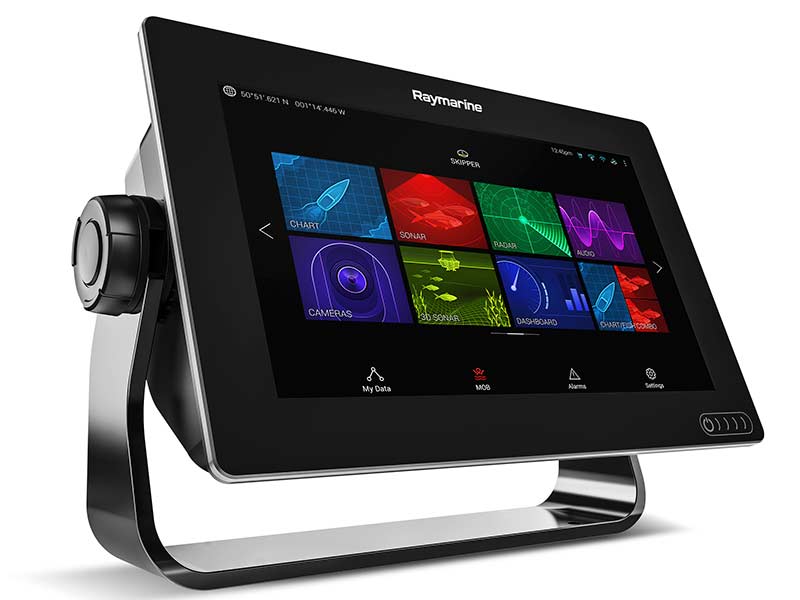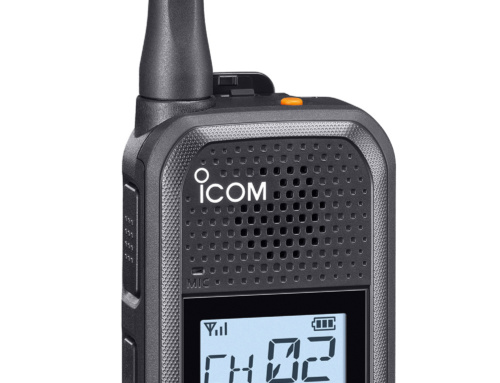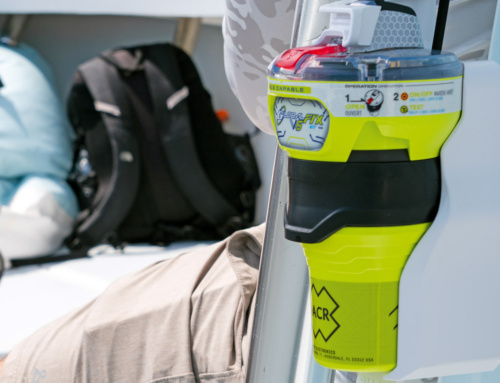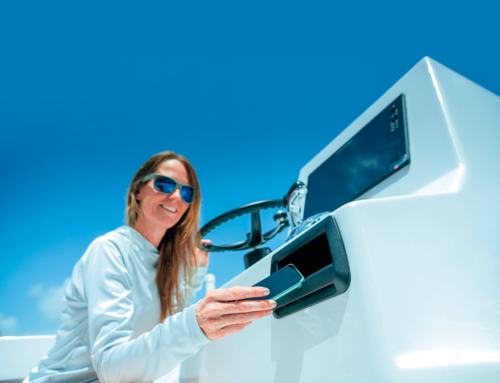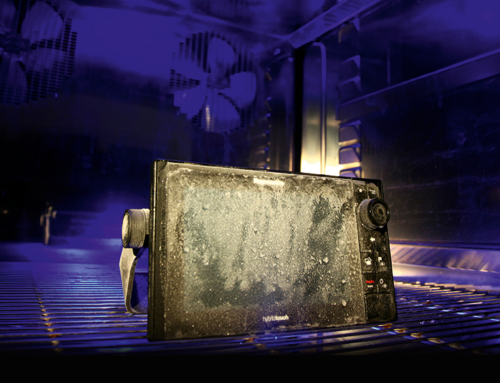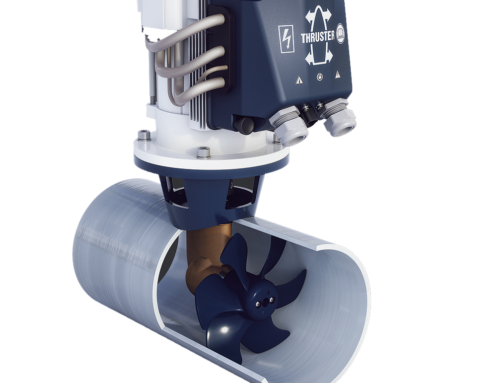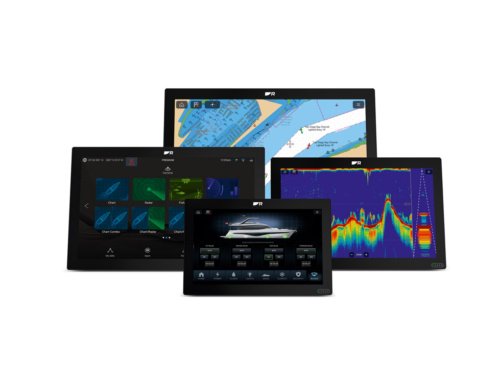- Being an easily installed plug-and-play set-up, and with such affordable hardware costs, these bits of kit will prove popular.
- The M100 and M200… are now offering a level of performance that five years ago would have cost three times the price.
Raymarine Axiom
Greg Copp examines the recently launched Axiom multifunction chart display system from Raymarine and explains how it works in combination with complementary technology …
With a seemingly never-ending procession of new electronics, I confess it is often hard to get excited about the latest high-tech electronics – that is, until Axiom was launched at this year’s Miami Boat Show. Axiom – a quad-core processor-powered multifunction chart display (MFD) – though impressive in itself, would not have been enough to drag me to Italy for a day out on Lake Maggiore. However, its new night vision thermal imaging (TI) cameras and latest RealVision 3D sonar systems, driven by Raymarine’s new LightHouse 3 operating system, are game-changing pieces of kit – and not just for those with big boats and deep pockets.
Axiom is the heart and LightHouse 3 its brain. Lighthouse 1 and 2 were their previous operating systems, and I understand that many MFDs driven by LightHouse 2 can be updated to 3. This new software enables the 7-, 9- and 12.1-inch all-glass touch screen MFDs to control a selection of external pieces of hardware in an easy, intuitive manner. Having had experience of Raymarine’s recent Dragonfly Pro 7 chartplotter/fish finder combination with Navionics charts, I was not surprised to find the Axiom just as easy to read in the bright Italian sun, and the system menu just as easy to stumble round.
The Axiom has a screen brightness of 1200 nits (unit of luminance). To put this into perspective, most LCD televisions have less than 400 nits, and any external display screen needs at least 700. I always find reading instructions for chartplotters incredibly laborious, so being able to quickly get to grips with Axiom, courtesy of its touch screen system and drop-down menus, was a bonus. What I liked in particular was the ability to drag data boxes like SOG and depth to where I wanted them on the chart display. It was particularly easy to configure the display into various multifunction modes at the flick of a finger. Considering the test boat had digital radar, TI night vision, a low-light intensification camera, RealVision 3D sonar and a chart display, all competing with information, Axiom needs to be able to simultaneously display all this, or quickly punch it up individually as needed – which it does very well. This is where its quad-core processor with twice the power of its predecessor MFDs comes in. If you need extra display space, then the built-in Wi-Fi and Bluetooth enables you to stream and control Axiom from a smartphone or tablet. You can also sync Axiom’s waypoints, routes and charts with a Navionics app.
The actual display itself sits very flush when dash-mounted, or it can be bracket-mounted. The tough glass face is optically bonded to the back casing, making it waterproof to IPX7 standard – more than capable of an exposed life in a lively open boat, with clear screen views from the most oblique angles. On a related subject, Raymarine have complemented Axiom with a small optional external control/key panel. This enables you to ‘screen-lock’ the display so all control has to be done via the external controls. In a lively open boat, this is a great feature when you can’t dab your fingers around the display – not to mention the problems of wearing gloves, or having your dash drenched by the weather. The display resolution of the 7- and 9-inch Axiom displays is 800 x 480, while the 12.1-inch MFD keeps images particularly sharp with a 1280 x 800 resolution. The Axiom 7 costs £745, the Axiom 9 £1,245, and the Axiom 12.1 will set you back £2,645 (all inc. VAT).
RealVision 3D Sonar
For many, especially anglers and divers, RealVision 3D sonar opens up a dimension never imagined – the ability to actually see what lies beneath the boat in detail, and as a three-dimensional image. RealVision achieves this through a combination of CHIRP DownVision, CHIRP SideVision, high-frequency CHIRP and RealVision 3D technology in a single transducer – either transom-mounted or a through-hull type. This enables a sonar scan on a wide spectrum – aft of the boat and out to each beam – but it does not paint a picture of what lies ahead. In order for this detailed image to have any clarity or accuracy, an ‘Attitude Heading Reference System’ is built into the transducer. This gyroscopic technology enables the system to stabilise an image that would otherwise be severely compromised by the effects of pitch, roll and yaw. For a single conventional transducer recording depth this is not really a problem.
RealVision 3D is limited to a depth of 300ft as the high-frequency transmissions used to achieve such a level of detail can’t penetrate depths beyond this. This is why CHIRP DownVision using a lower-frequency transmission is incorporated to provide depth readings down to 600ft. The beauty of RealVision is the software’s ability to display this underwater information as the user feels fit. You can configure multiple windows showing a conventional 2D depth profile, a 2D image out to each side and a 3D image of the seabed, and anything in between, like fish. The 3D technology actually allows you to pan the screen image around with your fingertips, so you can view from any angle, including looking up at the underside of your boat from the seabed.
Unfortunately, the bottom of Lake Maggiore was flat and devoid of wrecks, and the locals had eaten most of its inhabitants. However, it was possible to pick out the odd small group of fish, and as we came back into the marina you could see the individual bow mooring weights on the lake bed. Submerged objects are colour-coded for depth, with red being the closest to the surface, green mid-depth and blue the deepest – often on the seabed. This enables you to establish at a glance the approximate depth of an object within the 3D matrix displayed.
Thermal Imaging Night Vision
When US company FLIR acquired Raymarine back in 2010, the latter took on a new dimension. If you are unfamiliar with FLIR, they are one of the leading manufacturers of night vision equipment and have been supplying the US military since 1978. They have also had a big stake in providing pleasure boaters with the joys of seeing in the dark. After establishing themselves in the upper end of the market, they now offer two very effective and sensibly priced thermal imaging cameras, the M100 and the M200, costing £2,495 and £3,495 9 (inc. VAT), respectively. The difference between the two is simply that the M100 just tilts while the M200 tilts and pans. Both have a resolution of 320 x 240, and both can detect a person in the water at 450 metres or a small vessel at 1.3 kilometres. The M200, for another £1,000, is a no-brainer as you can pan around identifying navigational marks on either beam – ideal for night pilotage. More significantly, if combined with an Axiom display, you can hit the MOB button and the camera will instantly pan around 180 degrees and stay locked onto the point where your crewmember went overboard. Also, when used with Axiom, you can tap on a point on the chart, for example a landmark, and the camera will pan round and focus onto it. Control of the camera can either be via touch screen controls or you can drag a displayed camera view round with your finger, joystick or the Axiom external control panel. Both have a resolution of 320 x 240 and a 2x digital zoom.
The FLIR M100 and M200 are engineered with FLIR’s Boson high-performance thermal camera core, which features an integrated multi-core video processor delivering high image quality supported by artificial intelligence (AI). When the M100 and M200 are combined with a Raymarine Axiom MFD, users can take advantage of ClearCruise AI. ClearCruise is an intelligent thermal analytics program that visually and audibly alerts the helmsman when ‘non-water’ objects such as boats, obstacles or navigation markers are identified in the vicinity. If it picks up anything with a higher thermal signature than the water around it, it will frame it in the display, and keep the camera focused on it. On Lake Maggiore we put this to the test at night while navigating through various boats on swinging moorings, as the system would pick up the boat, display it, lock onto it and show us on the screen where it was in relation to our heading.
The great thing about TI for maritime use is that it can see through fog, and unlike image intensifiers (night sight/scope), which intensify ambient light, they can be used during daytime or in conditions of total darkness with zero ambient light. TI works by capturing infrared radiation emitted by an object. All objects emit infrared radiation in varying degrees depending on their temperature. This infrared radiation is at the bottom of the light spectrum and consequently can’t be detected by the naked eye. Only when an object like a metal is red hot does this infrared radiation move up the spectrum and become visible. The objective lens on a TI camera is made of a special metal, and is known as a ‘germanium’ lens. Through this lens it will scan its field of view at a rate of around 30 times a second, painting a picture known as a ‘thermogram’. This, in turn, is captured on a sensor in a similar way to a digital camera and then processed, producing an image.
TI systems available to the general public have had their limitations in the past, as well as being prohibitively expensive. One thing that is evident in the M100 and M200 is that they are now offering a level of performance that five years ago would have cost three times the price. Both these cameras are capable of picking up the heat energy that a small wave crest dissipates, enabling the system to show the sea state rather than a black expanse. Something you do have to be aware of is that you can lose a degree of perspective, especially if you stay focused on using thermal imaging too long. Both these cameras, courtesy of Ethernet, can work with displays from other brands, but you will not have features enabled by the LightHouse 3 operating system.
What makes Axiom, RealVision 3D and the M100/M200 camera series so effective is that they can be encompassed into one intuitive system that is sufficiently compact and durable to be mounted on a 6m RIB. Alternatively it is equally suited to being networked around a 60ft flybridge boat. Being an easily installed plug-and-play set-up, and with such affordable hardware costs, these bits of kit will prove popular.
Contact

